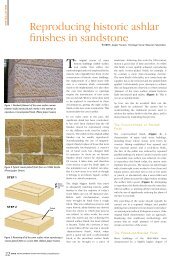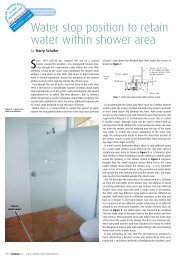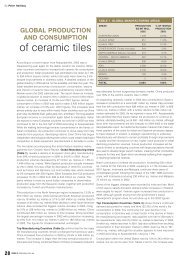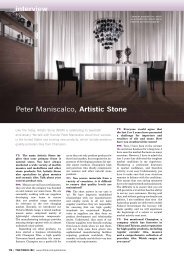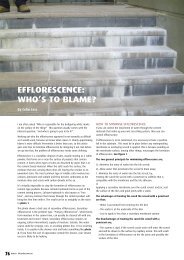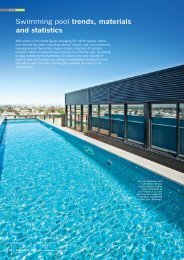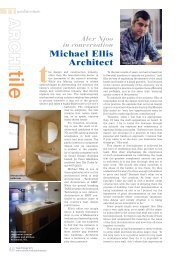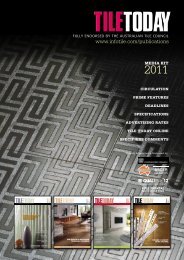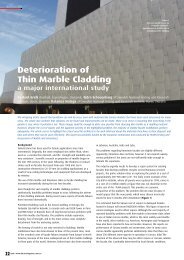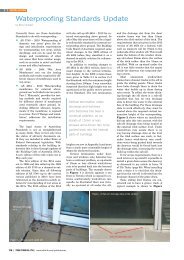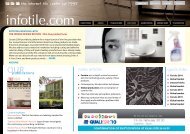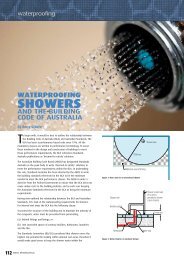Research & Development for Ceramic Tiles in the 21st ... - Infotile
Research & Development for Ceramic Tiles in the 21st ... - Infotile
Research & Development for Ceramic Tiles in the 21st ... - Infotile
You also want an ePaper? Increase the reach of your titles
YUMPU automatically turns print PDFs into web optimized ePapers that Google loves.
TT market<br />
Early generation photovoltaic<br />
energy is ma<strong>in</strong>ly<br />
based on <strong>the</strong> production of<br />
monocrystal or polycrystall<strong>in</strong>e<br />
silicon chips <strong>in</strong> cells to<br />
<strong>for</strong>m panels which, <strong>in</strong> turn,<br />
are fitted as totally <strong>for</strong>eign<br />
appendixes on build<strong>in</strong>gs.<br />
In this case, no ceramic or<br />
glass substrate is required<br />
<strong>for</strong> <strong>the</strong>se devices to work.<br />
However, second generation<br />
photovoltaic energy<br />
calls <strong>for</strong> sav<strong>in</strong>gs <strong>in</strong> raw materials<br />
(semiconductors),<br />
which at present means sacrific<strong>in</strong>g<br />
energy efficiency,<br />
and uses th<strong>in</strong> layers of different<br />
semiconductors <strong>in</strong> tandem<br />
(<strong>for</strong> selective absorption<br />
of different wavelengths) on<br />
glass, ceramic or even plastic<br />
substrates, giv<strong>in</strong>g rise to<br />
a technology now known as BiPV (built<strong>in</strong><br />
photovoltaics) 16 , i.e. <strong>the</strong>se devices<br />
<strong>for</strong>m an <strong>in</strong>tegral part of <strong>the</strong> build<strong>in</strong>g.<br />
In this generation, <strong>the</strong> substrate and<br />
<strong>the</strong> th<strong>in</strong> multilayer device are not two<br />
<strong>in</strong>dependent entities but ra<strong>the</strong>r build<strong>in</strong>g<br />
efficiency depends on <strong>the</strong> degree<br />
to which technically <strong>the</strong>y can be coupled<br />
toge<strong>the</strong>r, so <strong>the</strong>ir glass and/or ceramic<br />
character is essential. Although<br />
at present glass substrate panels have<br />
been much more widely implemented<br />
than ceramic-based panels, <strong>the</strong> latter<br />
possibly af<strong>for</strong>d greater <strong>in</strong>stallation opportunities.<br />
Consequently, certa<strong>in</strong> confidentiality<br />
exists regard<strong>in</strong>g <strong>the</strong> nature<br />
of <strong>the</strong>se ceramic bases when results<br />
are presented by specialist companies<br />
from <strong>the</strong> sector 17-18 ], although data is<br />
available about devices with mullite 19<br />
and zircon 20 substrates, among o<strong>the</strong>rs.<br />
F<strong>in</strong>ally, it should be mentioned that a<br />
third generation is currently be<strong>in</strong>g developed,<br />
although still at <strong>the</strong> research<br />
level, <strong>in</strong> which ceramic and glass materials<br />
may become an <strong>in</strong>tegral part of<br />
all <strong>the</strong> components <strong>in</strong> <strong>the</strong>se devices 21 .<br />
With regard to ceramics <strong>for</strong> energysav<strong>in</strong>g,<br />
an analysis of<br />
heat ga<strong>in</strong>s and losses<br />
<strong>in</strong> build<strong>in</strong>gs (efficiency)<br />
needs to be made from<br />
a climatic po<strong>in</strong>t of view,<br />
given that this affects<br />
potential markets with<br />
very different requirements.<br />
There<strong>for</strong>e, a<br />
first dist<strong>in</strong>ction should<br />
be made between two<br />
contrast<strong>in</strong>g situations:<br />
“daylight architecture”<br />
<strong>for</strong> cold climates and<br />
“sunlight architecture”<br />
<strong>for</strong> warm climates. In <strong>the</strong><br />
<strong>for</strong>mer case, emphasis<br />
is on <strong>the</strong> use of ceramic<br />
materials to absorb solar<br />
heat energy (dur<strong>in</strong>g<br />
<strong>the</strong> day), which is <strong>the</strong>n<br />
slowly released dur<strong>in</strong>g<br />
-<br />
O 2<br />
REDUCTION<br />
-<br />
OH<br />
REDUCTION<br />
H 2 O<br />
<strong>the</strong> night, while <strong>in</strong> <strong>the</strong> latter case, <strong>the</strong>se<br />
materials should not accumulate heat<br />
but ra<strong>the</strong>r enable night time ventilation<br />
of <strong>the</strong> build<strong>in</strong>g. In this sense, studies<br />
have been carried out on <strong>the</strong> near <strong>in</strong>frared<br />
reflectance of different <strong>in</strong>organic<br />
pigments 22 to obta<strong>in</strong> ceramics that help<br />
to prevent <strong>in</strong>door temperatures from<br />
ris<strong>in</strong>g, <strong>the</strong>reby provid<strong>in</strong>g energy sav<strong>in</strong>gs<br />
by reduc<strong>in</strong>g <strong>the</strong> time that air condition<strong>in</strong>g<br />
units need to be used.<br />
ceramics <strong>for</strong> com<strong>for</strong>t<br />
TiO 2<br />
(anatase)<br />
C.B.<br />
- “electron” e-<br />
O 2<br />
VB<br />
+ “hole” h-<br />
Figure 5. Simplified diagram of photocatalytic effect on TiO 2<br />
(anatase) surfaces. When ultraviolet radiation strikes <strong>the</strong> Ti-O<br />
b<strong>in</strong>d<strong>in</strong>g electrons, electronic transitions take place from <strong>the</strong><br />
valence band (VB) to <strong>the</strong> conduction band (CB), <strong>the</strong>reby enabl<strong>in</strong>g<br />
oxidisation and reduction reactions with <strong>the</strong> decomposition of<br />
certa<strong>in</strong> organic molecules <strong>in</strong> <strong>the</strong> atmosphere, NO x<br />
, etc.<br />
HEALTHCARE<br />
Safety<br />
Health<br />
Air quality<br />
(photocatalytic effect)<br />
Given that <strong>in</strong> many <strong>in</strong>dustrialised<br />
countries, we spend a large part of our<br />
time <strong>in</strong>doors (up to 90 per cent <strong>in</strong> <strong>the</strong><br />
so-called first world), it is easy to understand<br />
<strong>the</strong> importance of com<strong>for</strong>t,<br />
which <strong>in</strong> many cases is associated<br />
with productivity. This concept should<br />
be <strong>in</strong>terpreted <strong>in</strong> terms of:<br />
i) Noise and vibration: <strong>the</strong> importance<br />
and need <strong>for</strong> <strong>in</strong>sulation and<br />
especially noise <strong>in</strong>sulation and buffer<strong>in</strong>g<br />
is not limited to large-scale<br />
sports <strong>in</strong>stallations and swimm<strong>in</strong>g<br />
pools. These questions are of great<br />
importance <strong>in</strong> many <strong>in</strong>stances <strong>in</strong><br />
SMART CERAMICS<br />
ENERGY<br />
Production<br />
(photovoltaic,<br />
solar heat<strong>in</strong>g)<br />
Sav<strong>in</strong>g (climates)<br />
COMFORT<br />
Noise and vibrations<br />
Humidity<br />
Installation control<br />
Cultural diversity<br />
Figure 6. Diagram of <strong>the</strong> types of smart ceramics, separated <strong>in</strong>to three<br />
types of function: healthcare, energy and com<strong>for</strong>t.<br />
build<strong>in</strong>gs that have already<br />
been erected, especially <strong>for</strong><br />
economic solutions that do not<br />
entail large losses of space.<br />
ii) Humidity: humidity control<br />
by means of ceramic wall<br />
cover<strong>in</strong>gs is an <strong>in</strong>novative<br />
idea which is already be<strong>in</strong>g<br />
exploited by manufactur<strong>in</strong>g<br />
companies and consists<br />
of materials made of special<br />
bodies which absorb or emit<br />
water depend<strong>in</strong>g on <strong>the</strong> ambient<br />
moisture level.<br />
iii) Installation control: this<br />
is a field that has already been<br />
<strong>in</strong>itiated by certa<strong>in</strong> Spanish<br />
ceramic companies 23 and is<br />
based on <strong>the</strong> concept of “home<br />
automation”, which consists<br />
of <strong>in</strong>tegrat<strong>in</strong>g <strong>in</strong><strong>for</strong>mation<br />
technologies and telecommunications<br />
<strong>in</strong> <strong>the</strong> home. In this<br />
regard, automatic control systems<br />
have been developed <strong>for</strong> all <strong>the</strong> <strong>in</strong>stallations<br />
<strong>in</strong> a house, <strong>in</strong>clud<strong>in</strong>g<br />
tiles (by means of sensors and WiFi<br />
devices) which have <strong>the</strong> follow<strong>in</strong>g<br />
advantages: greater strength than<br />
current (plastic) devices, easier to<br />
clean, possibility of <strong>in</strong>corporat<strong>in</strong>g<br />
Braille codes, and versatility.<br />
iv) Cultural diversity: partially or<br />
totally subjective factors, preferred<br />
designs and/or particular<br />
beliefs. One particular aspect such<br />
as colour does not have <strong>the</strong> same<br />
mean<strong>in</strong>g or <strong>in</strong>fluence <strong>in</strong> <strong>the</strong> East<br />
as <strong>in</strong> <strong>the</strong> Western world. Although<br />
<strong>in</strong> Western Europe, it is possible<br />
that a sufficient number of houses<br />
already exist to cover <strong>the</strong> needs of<br />
<strong>the</strong> next generation, <strong>the</strong>re are numerous<br />
emerg<strong>in</strong>g markets where<br />
<strong>in</strong>dividual wooden build<strong>in</strong>gs are<br />
go<strong>in</strong>g to be replaced and/or extended<br />
by constructions where<br />
ceramics and glass will play a<br />
more prom<strong>in</strong>ent role. It should be<br />
noted <strong>in</strong> this respect that com<strong>for</strong>t<br />
is l<strong>in</strong>ked to daily issues -<strong>the</strong> natural<br />
stage <strong>for</strong> ceramics –<br />
which <strong>for</strong>tunately do not<br />
have <strong>the</strong> same relevance<br />
nor refer to <strong>the</strong> same daily<br />
rout<strong>in</strong>es <strong>in</strong> all cultures.<br />
conclusions<br />
Nowadays, <strong>the</strong> Spanish<br />
ceramic tile manufactur<strong>in</strong>g<br />
sector is highly homogenous<br />
with regard to<br />
<strong>the</strong> products it markets,<br />
<strong>the</strong> prom<strong>in</strong>ent features of<br />
which are surface decoration<br />
(glazes and pigments)<br />
and <strong>the</strong> colour<br />
of <strong>the</strong> fir<strong>in</strong>g body (<strong>the</strong><br />
substrate), when tiles<br />
with identical mechanical<br />
properties are compared.<br />
From a technical<br />
38 | Tile Today #74 | www.<strong>in</strong>fotile.com/publications



